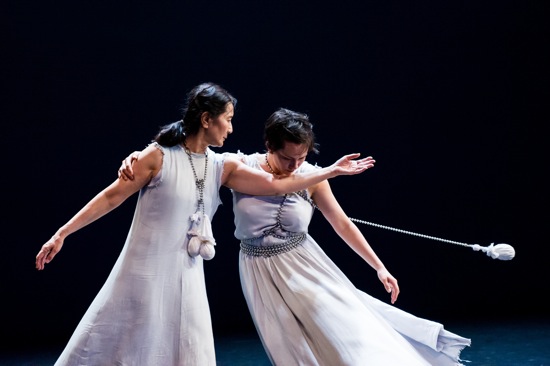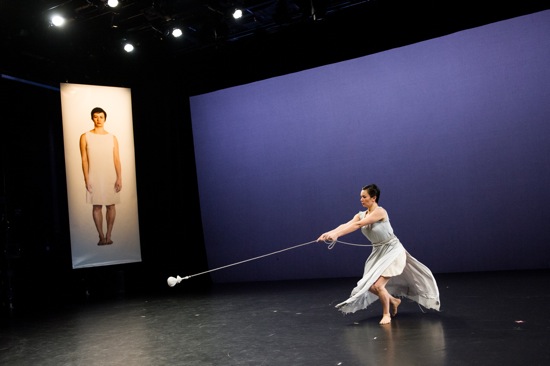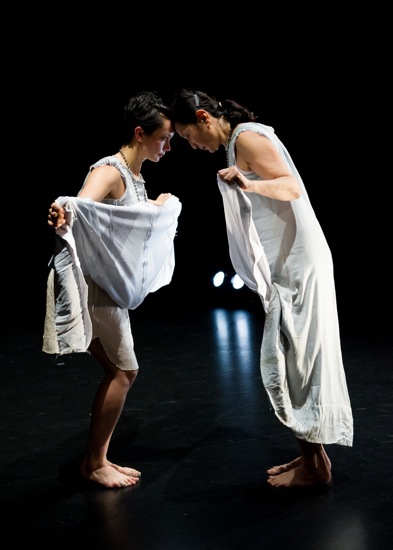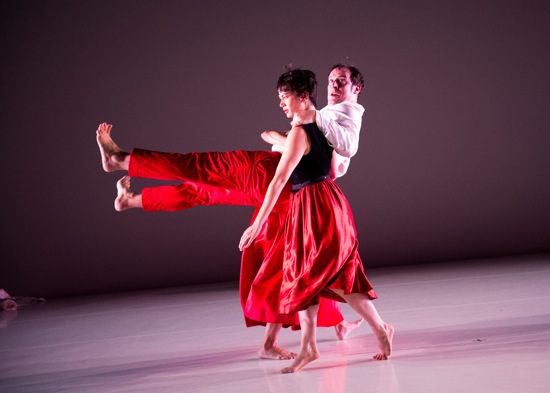Donna Uchizono Company premieres Fire Underground at New York Live Arts.
The title of Donna Uchizono’s harrowing new work is Fire Underground. The words evoke flames smoldering, unable to break through. Fire under the skin. Fire heating up the brain. Anger that has to be restrained. Uchizono makes no secret of the dance’s source. She spent twelve years adopting a child in Nepal and struggling to get a visa to bring her daughter to the U.S.
But Uchizono—always a profoundly interesting and individual choreographer—tells no story in Fire Underground. If you didn’t read her program note, you might not see her personal narrative in the piece, or be tempted to view its two performers, Uchizono and Rebecca Serrell Cyr, as mother and daughter, although Uchizono’s careworn face suggests an age difference between them, and an almost life-sized photo of Serrell Cyr hangs above one side of the stage. What you do see is that these two women are together but separated, striving in their different ways.
Uchizono’s movement images stand for seemingly endless journeys—whether in circles or along paths that fail to intersect. When Fire Underground begins, Serrell Cyr is spinning at the center of the stage. A silver chain, wrapped several times around her waist, bears at its far end a round white bundle of fabric, weighted with rice. She is neither unreeling herself from the chain nor winding further into it. But as David Shively’s fine, percussive score (music and sound design) becomes louder and then dwindles, she lifts the whirring circle made by the chain higher in the air and gradually reins it in.
Meanwhile, Uchizono stands to one side, bent over, her eyes on the ground, treading in place. Whizzing past her again and again and again, potentially dangerous, the ball at the end of the chain comes to seem like a message missing its mark or an umbilical cord anchored to no mother. When she moves from her spot, it is to run doggedly in a circle, gathering up her white dress in front of her. She looks perturbed, searching for something.
You might relate Uchizono’s choreographic collage of images to her terrible international adoption battles (now, happily, resolved), but the memories and feelings have been abstracted, pared down to their essences—sometimes in mysterious ways. It is easy to see why Serrell Cyr might display an array of facial expressions—now smiling at us, now squinting, now looking supercilious. More enigmatic are the women’s outfits—essentially shapeless, ragged-edged, white cotton shifts. But Serrell Cyr’s dress is open at the back; she is naked underneath it, and we catch occasional glimpses of her buttocks. Although Uchizono wears flesh-colored trunks, when she holds her dress up—as she does for many minutes, she gives the impression of purposefully revealing her pubic area.
Serrell Cyr shows no emotion when she spins with the long, weighted chain; she’s in a kind of limbo, completely wrapped up in her task. At one point, Uchizono takes up two similar balls at the ends of shorter chains and begins to whirl them on either side of her—first in the same direction, then in opposition. The music becomes rhythmic, jangly. Eventually the spinning balls begin to create the illusion of continuous wheels. I’m reminded of the poi balls that figure in Maori dances, and link Fire Underground to the practice of dancing with poi that have been set on fire. If you watch an online video, shot at night, you can see how the balls’ fiery traceries slip in and out of more complex synchrony and how their patterns might meet (or tangle and come to a fiery halt). Uchizono works as if conjuring up energy and harmony.
How will these two women come together? What can be taken as favorable omens? That Joe Levasseur’s lighting sometimes blends their shadows? That Serrell Cyr rearranges her clothing to become less naked? That the two circle, pressed brow to brow? That they travel back to back, making intricate, perfectly synchronized little stepping patterns? One beautifully revealing moment occurs when they stand side by side beneath the photo of Serrell Cyr and begin swinging their arms in patterns that are the same, yet not the same—slipping in and out of synchrony.
Sometimes they look lost, pushed together and apart by tides they can’t control. In the end, Serrell Cyr again spins with the weighted chain (longer now); faster and faster she goes, and then slows down. The lights go out.
Uchizono’s travails to bring her adopted daughter home ended in 2011. As of 2010, 80 prospective families were still caught in the “Nepal Pipeline.”
Fire Underground was preceded on the NYLA program by two wonderfully odd and smart early works by Uchizono, short tahitian temper (1990) and State of Heads (1999). The first is indeed short, and the choreographer performed it with a different duo of dancers at each performance. The wit lies in its little assault on our expectations. Three women (I saw Michelle Boulé and Anna Carapetyan with Uchizono) stand with their backs to us, hugging themselves and swaying their hips as they tread in time to traditional Tahitian music. But this is no seductive come-on; suddenly they look back over their shoulders at us and unleash a stream of silent vituperation, then return to their dance, which now suggests a smoldering volcano. In the end, they emit a concerted scream of rage.
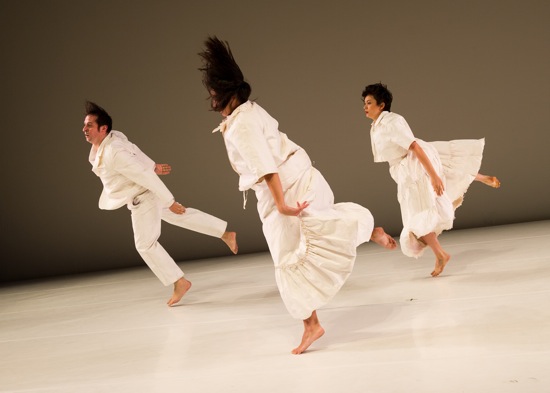
(L to R) Levi Gonzalez, Hristoula Harakas, and Rebecca Serrell Cyr in Donna Uchizono’s State of Heads. Photo: Ian Douglas
State of Heads starts almost immediately after the blackout that ends the trio. There’s a reverberating crash and a blare of white light. Remember 1999? Avalanches killed ten or more in the Alps, a thousand died in an earthquake in Colombia, and people got very weird about the coming millennium. Uchizono’s title puns on “heads of state,” those important officials who often seem disconnected with the body politic.
Stan Pressner’s terrific lighting and James Lo’s wonderfully evocative score of peculiar, yet familiar sounds isolate the dancers in a kind of limbo that is, nonetheless fraught with association. When the piece begins, a man in a bulky white suit (Levi Gonzalez, a member of the original cast) stands at the rear of the stage with his back to us; he doesn’t move for a very long time.
Meanwhile, Serrell Cyr and Hristoula Harakas toddle in from opposite sides of the stage. They, too, are immured in their clothing—bunchy white dresses. Their bobbling heads look too small for their bodies. They stumble into a side-by-side stance facing us and stare at their feet for a while, before working them into a turned-out position like good little ballet students. But they’re pathetically, hilariously uncoordinated and discombobulated. They look at the sky, stare at each other, flap their hands, roll their eyes. A tweet in Lo’s score makes them Gonzalez turn and join them, screwing his feet into the desired pose. Sometimes the three resemble dolls, sometimes they look like chickens. They seem to be lost in a scenario that no one has explained to them. They point at one another ineptly (or were those guns?). Serrell Cyr picks an imaginary flower and dislodges a bee; Gonzalez puts another flower we can’t see behind his ear.
The three are, however, prepared to dance for us, to present themselves as handsome, glamorous people (so that’s what Harakas’s bright red lipstick was portending). They gradually divest themselves of their clunky attire and swan around in red form-fitting tops, with skirts for the women (wait, is that a Spanish folk dance we’re looking at?). They skirmish; they dance to beat the band. It’s a wild experience watching some very expert dancers knock themselves out performing movement that’s demanding and elegantly organized, yet makes them look seriously nuts.

